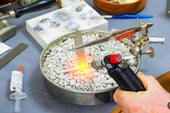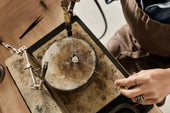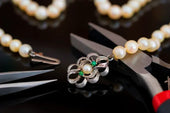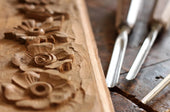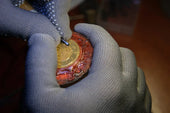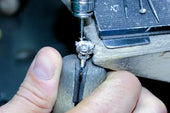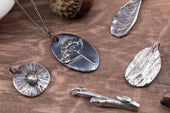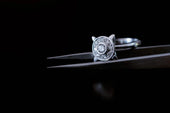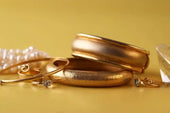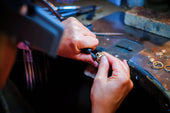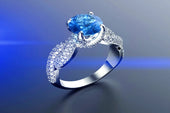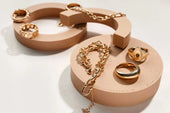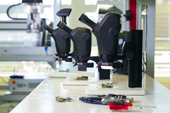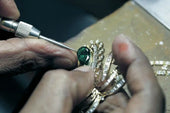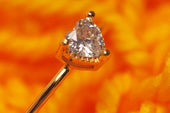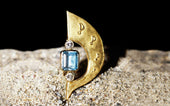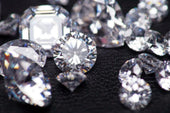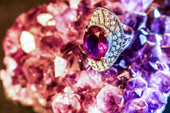Titanium jewelry has risen to prominence in recent years, becoming the most talked about “material of the future” in the jewelry industry. How did this metal, once reserved for the aerospace and medical fields, transform into a fashion favorite? In this article, we'll explore the secrets of titanium jewelry through a combination of craftsmanship and science - especially through the use of a stereo microscope, where we'll discover microscopic art that's difficult for the naked eye to discern.
History of Titanium Jewelry
The history of titanium jewelry can be called “cross-border”:
1950s: Pure titanium was first used in the skeletons of military airplanes, shocking the industrial world with its “high strength and light weight” characteristics.
1980s: Japanese craftsmen broke through the titanium processing problems, giving birth to the first titanium wedding rings, the unit price is comparable to a luxury car.
2000s: Italian jewelers introduced anodic oxidation technology to achieve the color-changing effect of titanium.
2020s: Titanium jewelry enters the era of micron-sized precision work with the help of stereo microscope and laser engraving technology.
Behind this material revolution, is the stereo microscope and other precision instruments to promote technological innovation - when the traditional magnifying glass was replaced by a 200 times the microscope head, the artisan was able to carve patterns on the scale of the diameter of a hair.

Six core advantages of titanium jewelry
1. Bacteria inhibition
Certified by ISO 22196, titanium has an inhibition rate of 99.3% against Escherichia coli and Staphylococcus aureus. Stereo microscope observation shows that its surface oxide film forms a nano-scale dense structure, like a natural antibacterial barrier.
2. Anti-corrosion
In the simulated sweat immersion experiment, the corrosion rate of titanium is only 1/38 of that of silver, and its oxidized film maintains a stable crystal structure in acidic and alkaline environments as seen by stereo microscopy.
3. Light weight
The same volume of titanium jewelry is 56% lighter than gold, but has a higher strength. NASA data show that the titanium alloy specific strength (strength / density) is 3 times that of stainless steel.
4. High Safety
The biocompatibility of medical grade titanium (Gr5) is certified by ISO 5832-11, and over 20 million people worldwide have implanted titanium orthopedic devices. Surface treatment technology under stereo microscope ensures zero risk of allergy. Consumers who buy titanium jewelry are guaranteed not to have any allergic reactions when wearing it.
5. Multiple colors
By controlling the thickness of the oxide film (80-400nm) with voltage and using the principle of light interference to produce the iridescent effect, the naked eye can see a variety of colors of light refracted from the titanium metal. With the help of stereo microscope, you can also see the nano-layer on the surface of titanium like an oil film showing structural color changes.

How to Engrave Simple Titanium Jewelry
It is because of the multiple advantages of titanium that many famous jewelry brands now prefer to introduce new titanium jewelry. Of course, engraving enthusiasts can make their own simple creations, and the following is the process involved.
Preparation tool list
Titanium plate: Beginners are recommended to choose 0.8mm thickness of easy to carve, moderate hardness. You can prepare a few more titanium plates to improve the tolerance rate.
Engraving tools: a pen-type electric etching machine (voltage 12V) or a pneumatic engraving machine. Engraving titanium requires specialized engraving tools.
Stereo microscope: We recommend a stereo microscope with 40-100x zoom to ensure that all details can be handled.
Four-step creative process
1. Microscopic Design
The engraver needs to design the engraving pattern in advance. Simple patterns can be marked and drawn directly on the titanium plate. For complex patterns, it is recommended to use a computer to calculate the data for the pattern and then draw the pattern with an etching pen under the stereo microscope.
2. Electrolytic etching
Set the current 0.5A/cm², etching depth control at 50-80 microns, need to be monitored in real time through the stereo microscope scale.
3. Nano-coloring
Processing at 15V for 30 seconds to obtain gold color, 25V for 90 seconds to show indigo blue, in order to ensure that the engraved color meets the expectations, the stereo microscope needs to be calibrated in a timely manner to improve the accuracy.
4. Micropolishing
Using 0.1 μm diamond abrasive paste, microscopic polishing was performed under the microscope to eliminate micrometer scratches. Because the β-crystalline phase region of titanium is more easily colored as seen under the stereo microscope, a color gradient effect can be created by localized heat treatment.

Conclusion
Titanium jewelry is not only a material innovation, but also a visual revolution in the microcosm. Through the stereo microscope, we can see the nano oxidized layer and micron etching hidden under the luster of titanium, which is the code for the fusion of technology and art. With the advancement of science and technology, the future of titanium jewelry may appear holographic micro-relief, dynamic color-changing coatings and other black technology. Creators are advised to invest in a professional stereo microscope - it is not only a quality inspection tool, but also a key to open the dimension of microscopic creation.


